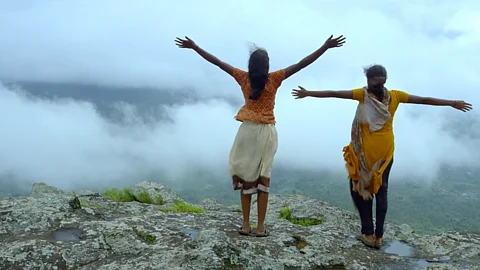
- HOMEGROWN WORLD
- #HGCREATORS
- #HGEXPLORE
- #HGVOICES
- #HGSHOP
- CAREERS
- ABOUT US
- CONTACT US

India’s sacred heartland glimmers with the stories of the Adivasis, its indigenous people. Preserved in the resin of time, their traditions and mythology have remained in our subconscious like primordial memories.
However, their ways of life have been distorted by the systemic othering they experience in our villages, town squares and public offices. Divorced from the woodlands and rural communities, policymakers and cinema-goers alike share a warped vision of indigenous people.
Article 342 of our Constitution officially recognises close to 730 ethnic groups as ‘Scheduled Tribes’. Nonetheless, their appearance in our visual media continues to be tokenistic and subservient to non-indigenous, upper caste characters. It's rare to see them as protagonists, either in our narratives or our politics.
The history of Indian cinema, in fact, has been besmirched with problematic archetypes of Adivasis by characterising them as barbaric, lascivious, uncivilised or opportunistic people.
In April 2017, a band of naxalites attacked a team of CRPF personnel in the Maoist-riddled Sukma district of Chattisgarh, killing 25 jawans of the paramilitary force. In swift response, 121 tribal men were rounded up and arrested for this ambush.
Later in the same year, we saw the release of Newton, a Hindi language political satire directed by Amit Masurkar. The movie recounts the tale of an electoral clerk – named Newton – who is sent to the Dandakaranya region in Chattisgarh to conduct a fair election for tribal voters. As you free-fall into the center of gravity in this story, you will realise that not everyone lands the same way, the caste system and urban elitism can cushion some while splitting the heads of others.
For the police and paramilitary who see themselves in an avuncular, watchdog role charged with the heavy burden of national security, Dandakaranya is a battleground for reactionary warfare. But for the Gond tribe, these forests are their home.
A crucial contribution of Newton was how it began to scrub the murky lens through which we see forest-dwelling tribal communities as interchangeable with or sympathetic to Maoist rebels.
In March 2021, the aforementioned Gond tribe of Chattisgarh announced their collective decision to discard their age-old cremation practice in favour of protecting the trees cut down to build the funeral pyres. This gesture of goodwill was testament to how seriously the adivasis treat their responsibility of stewardship towards the natural heritage of our country and how they are not as backward as our media likes to depict them.
In November of 2021, a Tamil film called Jai Bhim was released to unanimously positive reviews. It tells a story about an activist-lawyer who pursues justice for a poor adivasi man, falsely accused of robbery. While the film was praised for its bleak and authentic portrayal of custodial brutality and oppression that the Irula people undergo because of their historical association with criminality, many detractors were of the opinion that the film subscribed to a Brahminical saviour trope.
In movies, what we are looking at and who’s doing the looking can manifest as two opposite entities sharing an electrochemical bond. There is a power dynamic that exists between the viewer and the object of their gaze. And this is why representation that’s sensitive and respectful to any community or faction of society can be very important.
A film that was recently balked at for misrepresenting tribal ceremonies is Kantara, a Kannada-language thriller released in 2022. While the themes of greed, land rights and man’s inherent symbiosis with nature are sketched out beautifully in the script, the critics say that Kantara appropriates the adivasi ritual of Bhoota Kola to fit a more majoritarian, Vedic narrative. In multiple scenes, the Tulu adivasis are depicted praying to Hindu gods like Shiva and Vishnu instead of the subaltern, household deities symbolising forces of nature and the forests that watch over them.
Another troubling feature imbibed by conventional filmmakers has been the casting of actors from an upper-class or non-indigenous background to play the role of adivasis on screen. This inadvertently leads to a lack of authenticity and underrepresentation of indigenous people in our country’s visual media.
A film that recently dismantled this stereotype was Dhabari Quruvi, released in November 2022 and narrated entirely in the Irula language. Directed by Priyanandan, the plot revolves around a tribal girl as she defies convention and reclaims agency over her body and her destiny. The director put close to 150 people through an acting workshop, at the end of which, he cast around sixty non-actors belonging to Irula, Muduka, Kurumba and Vaduka tribal communities of Attappadi, a scheduled tribe village in the southern Indian state of Kerala. Quite a few of them had never seen a film before.
In July 2022, the 121 tribal men who had been arrested for aiding in the Sukma Maoist ambush of 2017 were all acquitted for lack of evidence. In the same month, Smt. Droupadi Murmu was elected as the first Indigenous woman to serve in the nation’s highest office of President. Belonging to a Santhali family from the Uparbeda village in Odisha, Smt Murmu embodies the hope that socio-cultural roles or economic potential assigned at one’s birth will not hold us back from achieving our heart’s innermost desires.
The mythology passed down in oral and written records by our indigenous people is mind-bending in its originality and deserves faithful, decolonized adaptations in their own voices. Their folklore, rituals of worship, household deities and infallible instincts for natural conservation have been imprinted upon our cultural canvas, leaving clues in plain sight that can lead us back to our roots.
If you appreciated this piece, here's more from Homegrown:
Disaibon Hul Is The Children's Book On Adivasi History We All Need To Read
The Art Village That’s Empowering The Adivasi Community In Panchgani
